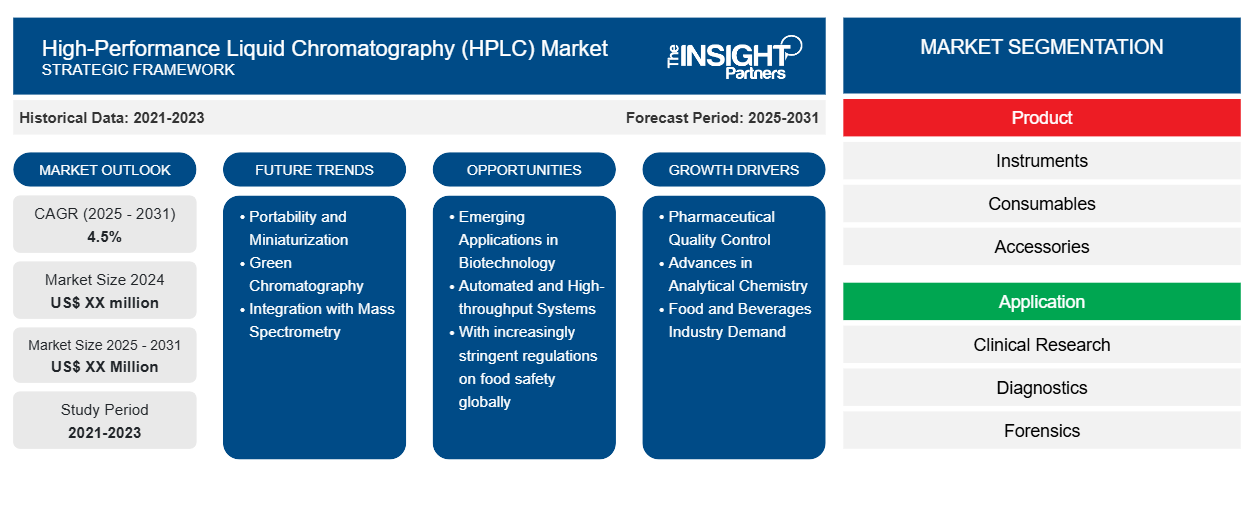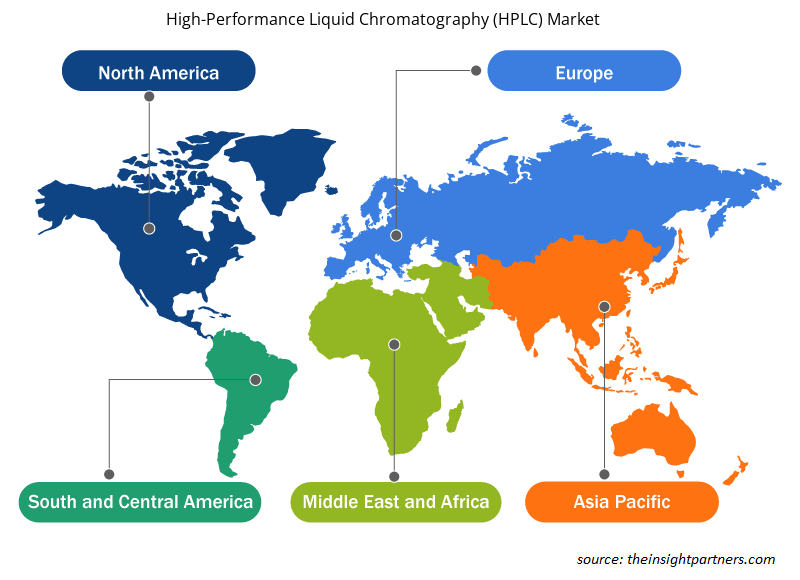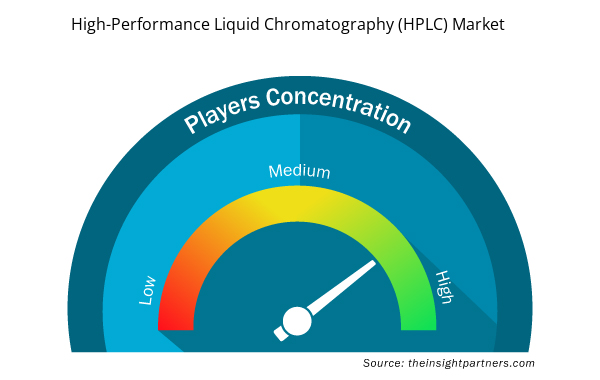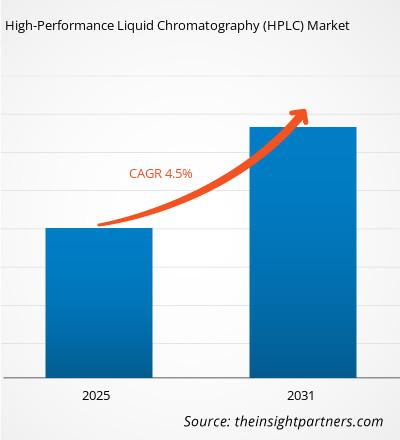Für den Markt für Hochleistungsflüssigkeitschromatographie (HPLC) wird von 2025 bis 2031 eine durchschnittliche jährliche Wachstumsrate (CAGR) von 4,5 % erwartet, wobei die Marktgröße von XX Millionen US-Dollar im Jahr 2024 auf XX Millionen US-Dollar im Jahr 2031 anwachsen wird.
Der HPLC-Markt ist nach Produkten in die folgenden Untersegmente unterteilt: Instrumente, Verbrauchsmaterial und Zubehör. Darüber hinaus wird eine Analyse nach Anwendungsbereichen wie klinischer Forschung, Diagnostik, Forensik und anderen Anwendungen präsentiert. Die globale Analyse ist nach Regionen und wichtigen Ländern aufgeschlüsselt. Die Marktbewertung für die obige Segmentanalyse erfolgt in US-Dollar.
Zweck des Berichts
Der Bericht „High-Performance Liquid Chromatography (HPLC) Market“ von The Insight Partners beschreibt die aktuelle Marktsituation und das zukünftige Wachstum sowie die wichtigsten Treiber, Herausforderungen und Chancen. Er liefert Einblicke für verschiedene Geschäftsinteressenten, wie zum Beispiel:
- Technologieanbieter/-hersteller: Um die sich entwickelnde Marktdynamik zu verstehen und die potenziellen Wachstumschancen zu kennen, können sie fundierte strategische Entscheidungen treffen.
- Investoren: Um eine umfassende Trendanalyse hinsichtlich der Marktwachstumsrate, der finanziellen Marktprognosen und der Chancen entlang der Wertschöpfungskette durchzuführen.
- Regulierungsbehörden: Sie regulieren die Richtlinien und polizeilichen Aktivitäten auf dem Markt mit dem Ziel, Missbrauch zu minimieren, das Vertrauen der Anleger zu wahren und die Integrität und Stabilität des Marktes aufrechtzuerhalten.
Marktsegmentierung für Hochleistungsflüssigkeitschromatographie (HPLC)
Produkt
- Instrumente
- Verbrauchsmaterial
- Zubehör
Anwendung
- Klinische Forschung
- Diagnose
- Forensik
- Andere Anwendungen
Passen Sie diesen Bericht Ihren Anforderungen an
Sie erhalten kostenlos Anpassungen an jedem Bericht, einschließlich Teilen dieses Berichts oder einer Länderanalyse, eines Excel-Datenpakets sowie tolle Angebote und Rabatte für Start-ups und Universitäten.
Markt für Hochleistungsflüssigkeitschromatographie (HPLC): Strategische Einblicke

- Informieren Sie sich über die wichtigsten Markttrends in diesem Bericht.Dieses KOSTENLOSE Beispiel umfasst eine Datenanalyse, die von Markttrends bis hin zu Schätzungen und Prognosen reicht.
Wachstumstreiber auf dem Markt für Hochleistungsflüssigkeitschromatographie (HPLC)
- Pharmazeutische Qualitätskontrolle: Die Nachfrage seitens der pharmazeutischen Qualitätskontrolle besteht darin, dass Arzneimittel auf HPLC angewiesen sind, um die richtigen Qualitätskontrolltests durchzuführen, und der Anstieg ist auf die steigende Nachfrage zurückzuführen.
- Fortschritte in der analytischen Chemie: Fortschritte in der Chromatographietechnologie, insbesondere hinsichtlich Empfindlichkeit und Automatisierung, maximieren das Potenzial der HPLC.
- Nachfrage in der Lebensmittel- und Getränkeindustrie: HPLC wird häufig in der Lebensmittelsicherheit und bei Tests auf Verunreinigungen, Konservierungsstoffe und Zusatzstoffe eingesetzt, daher steigt die Nachfrage in der Lebensmittel- und Getränkeindustrie rasant an.
Zukünftige Trends auf dem Markt für Hochleistungsflüssigkeitschromatographie (HPLC)
- Tragbarkeit und Miniaturisierung: Der Trend zur HPLC-Miniaturisierung bietet tragbare Systeme, die Tests vor Ort und einen verbesserten Zugang zu qualitativ hochwertigen Analysen auf breiter industrieller Basis ermöglichen.
- Grüne Chromatographie: Der zunehmende Fokus auf Nachhaltigkeit hat zu einem wichtigen Markttrend hin zu „grünen“ Chromatographielösungen geführt, die den Lösungsmittelverbrauch reduzieren und die Umwelteffizienz verbessern.
- Integration mit Massenspektrometrie: HPLC wird nun mit Massenspektrometrie (LC-MS) kombiniert. LC-MS verbessert die Detektion und chemische Analyse von pharmazeutischen und umweltbezogenen Anwendungen.
Marktchancen für die Hochleistungsflüssigkeitschromatographie (HPLC)
- Neue Anwendungen in der Biotechnologie: Mit der zunehmenden Verbreitung der Biotechnologie und Gentherapie bietet der Einsatz von HPLC zur Analyse komplexer biologischer Proben Spielraum für Marktwachstum.
- Automatisierte und Hochdurchsatzsysteme: Automatisierung und Hochdurchsatzfähigkeit in der HPLC bieten die Chance auf mehr Effizienz, Einsparungen bei den Arbeitskosten sowie Produktion und Tests im kommerziellen Maßstab in der Pharmaindustrie und in der Forschung.
- Angesichts der weltweit immer strengeren Vorschriften zur Lebensmittelsicherheit werden HPLC-basierte Testlösungen in Entwicklungsländern, in denen die Anforderungen an die Lebensmittelsicherheit steigen, immer beliebter.
Regionale Einblicke in den Markt für Hochleistungsflüssigkeitschromatographie (HPLC)
Die Analysten von Insight Partners haben die regionalen Trends und Faktoren, die den Markt für Hochleistungsflüssigkeitschromatographie (HPLC) im Prognosezeitraum beeinflussen, ausführlich erläutert. Dieser Abschnitt behandelt auch die Marktsegmente und die geografische Lage der Hochleistungsflüssigkeitschromatographie (HPLC) in Nordamerika, Europa, Asien-Pazifik, dem Nahen Osten und Afrika sowie Süd- und Mittelamerika.

- Erhalten Sie regionale Daten zum Markt für Hochleistungsflüssigkeitschromatographie (HPLC)
Umfang des Marktberichts zur Hochleistungsflüssigkeitschromatographie (HPLC)
| Berichtsattribut | Details |
|---|---|
| Marktgröße im Jahr 2024 | XX Millionen US-Dollar |
| Marktgröße bis 2031 | XX Millionen US-Dollar |
| Globale CAGR (2025 – 2031) | 4,5 % |
| Historische Daten | 2021-2023 |
| Prognosezeitraum | 2025–2031 |
| Abgedeckte Segmente | Nach Produkt
|
| Abgedeckte Regionen und Länder | Nordamerika
|
| Marktführer und wichtige Unternehmensprofile |
|
Marktteilnehmerdichte im Bereich Hochleistungsflüssigkeitschromatographie (HPLC): Auswirkungen auf die Geschäftsdynamik
Der Markt für Hochleistungsflüssigkeitschromatographie (HPLC) wächst rasant. Dies wird durch die steigende Endverbrauchernachfrage aufgrund veränderter Verbraucherpräferenzen, technologischer Fortschritte und eines stärkeren Bewusstseins für die Produktvorteile vorangetrieben. Mit der steigenden Nachfrage erweitern Unternehmen ihr Angebot, entwickeln Innovationen, um den Verbraucherbedürfnissen gerecht zu werden, und nutzen neue Trends, was das Marktwachstum weiter ankurbelt.
Die Marktteilnehmerdichte beschreibt die Verteilung der in einem bestimmten Markt oder einer bestimmten Branche tätigen Unternehmen. Sie gibt an, wie viele Wettbewerber (Marktteilnehmer) in einem bestimmten Marktraum im Verhältnis zu dessen Größe oder Gesamtmarktwert präsent sind.
Die wichtigsten Unternehmen auf dem Markt für Hochleistungsflüssigkeitschromatographie (HPLC) sind:
- Gewässer
- Agilent Technologies
- Shimadzu Corporation
- Thermo Fisher Scientific Inc.
- Allgemeine Elektricitätsgesellschaft
Haftungsausschluss : Die oben aufgeführten Unternehmen sind nicht in einer bestimmten Reihenfolge aufgeführt.

- Überblick über die wichtigsten Akteure auf dem Markt für Hochleistungsflüssigkeitschromatographie (HPLC)
Wichtige Verkaufsargumente
- Umfassende Abdeckung: Der Bericht deckt die Analyse von Produkten, Dienstleistungen, Typen und Endbenutzern des Marktes für Hochleistungsflüssigkeitschromatographie (HPLC) umfassend ab und bietet eine ganzheitliche Landschaft.
- Expertenanalyse: Der Bericht basiert auf dem umfassenden Verständnis von Branchenexperten und Analysten.
- Aktuelle Informationen: Der Bericht gewährleistet Geschäftsrelevanz durch die Berichterstattung über aktuelle Informationen und Datentrends.
- Anpassungsoptionen: Dieser Bericht kann angepasst werden, um den spezifischen Kundenanforderungen gerecht zu werden und die Geschäftsstrategien optimal anzupassen.
Der Forschungsbericht zum Markt für Hochleistungsflüssigkeitschromatographie (HPLC) kann daher dazu beitragen, die Branchensituation und die Wachstumsaussichten zu entschlüsseln und zu verstehen. Obwohl es einige berechtigte Bedenken gibt, überwiegen die Vorteile dieses Berichts tendenziell die Nachteile.
- Historische Analyse (2 Jahre), Basisjahr, Prognose (7 Jahre) mit CAGR
- PEST- und SWOT-Analyse
- Marktgröße Wert/Volumen – Global, Regional, Land
- Branche und Wettbewerbsumfeld
- Excel-Datensatz



Report Coverage
Revenue forecast, Company Analysis, Industry landscape, Growth factors, and Trends

Segment Covered
This text is related
to segments covered.

Regional Scope
North America, Europe, Asia Pacific, Middle East & Africa, South & Central America

Country Scope
This text is related
to country scope.
Häufig gestellte Fragen
Some of the customization options available based on request are additional 3-5 company profiles and country-specific analysis of 3-5 countries of your choice. Customizations are to be requested/discussed before making final order confirmation, as our team would review the same and check the feasibility.
The report can be delivered in PDF/PPT format; we can also share excel dataset based on the request.
Key manufacturers of High-Performance Liquid Chromatography (HPLC) consist of Waters, Agilent Technologies, Shimadzu Corporation, Thermo Fisher Scientific Inc., General Electric Company, PerkinElmer, Inc., Bio-Rad Laboratories, Inc. JASCO, Phenomenex Inc., Gilson, Inc.,
The market is expected to register a CAGR of 4.5% during 2023-2031.
Some of the key drivers include rise in quality control in pharmaceuticals, the demand for accurate environmental monitoring, and the increasing use of HPLC in biotechnology and food safety testing.
Future trends of the High-Performance Liquid Chromatography (HPLC) Market include more compact and user-friendly HPLC systems, integration of HPLC with other analytical technologies, and increasing adoption of HPLC in emerging markets.
Trends and growth analysis reports related to Life Sciences : READ MORE..
The List of Companies
1. Waters
2. Agilent Technologies
3. Shimadzu Corporation
4. Thermo Fisher Scientific Inc.
5. General Electric Company
6. PerkinElmer, Inc.
7. Bio-Rad Laboratories, Inc.
8. JASCO
9. Phenomenex Inc.
10. Gilson, Inc.
The Insight Partners performs research in 4 major stages: Data Collection & Secondary Research, Primary Research, Data Analysis and Data Triangulation & Final Review.
- Data Collection and Secondary Research:
As a market research and consulting firm operating from a decade, we have published and advised several client across the globe. First step for any study will start with an assessment of currently available data and insights from existing reports. Further, historical and current market information is collected from Investor Presentations, Annual Reports, SEC Filings, etc., and other information related to company’s performance and market positioning are gathered from Paid Databases (Factiva, Hoovers, and Reuters) and various other publications available in public domain.
Several associations trade associates, technical forums, institutes, societies and organization are accessed to gain technical as well as market related insights through their publications such as research papers, blogs and press releases related to the studies are referred to get cues about the market. Further, white papers, journals, magazines, and other news articles published in last 3 years are scrutinized and analyzed to understand the current market trends.
- Primary Research:
The primarily interview analysis comprise of data obtained from industry participants interview and answers to survey questions gathered by in-house primary team.
For primary research, interviews are conducted with industry experts/CEOs/Marketing Managers/VPs/Subject Matter Experts from both demand and supply side to get a 360-degree view of the market. The primary team conducts several interviews based on the complexity of the markets to understand the various market trends and dynamics which makes research more credible and precise.
A typical research interview fulfils the following functions:
- Provides first-hand information on the market size, market trends, growth trends, competitive landscape, and outlook
- Validates and strengthens in-house secondary research findings
- Develops the analysis team’s expertise and market understanding
Primary research involves email interactions and telephone interviews for each market, category, segment, and sub-segment across geographies. The participants who typically take part in such a process include, but are not limited to:
- Industry participants: VPs, business development managers, market intelligence managers and national sales managers
- Outside experts: Valuation experts, research analysts and key opinion leaders specializing in the electronics and semiconductor industry.
Below is the breakup of our primary respondents by company, designation, and region:

Once we receive the confirmation from primary research sources or primary respondents, we finalize the base year market estimation and forecast the data as per the macroeconomic and microeconomic factors assessed during data collection.
- Data Analysis:
Once data is validated through both secondary as well as primary respondents, we finalize the market estimations by hypothesis formulation and factor analysis at regional and country level.
- Macro-Economic Factor Analysis:
We analyse macroeconomic indicators such the gross domestic product (GDP), increase in the demand for goods and services across industries, technological advancement, regional economic growth, governmental policies, the influence of COVID-19, PEST analysis, and other aspects. This analysis aids in setting benchmarks for various nations/regions and approximating market splits. Additionally, the general trend of the aforementioned components aid in determining the market's development possibilities.
- Country Level Data:
Various factors that are especially aligned to the country are taken into account to determine the market size for a certain area and country, including the presence of vendors, such as headquarters and offices, the country's GDP, demand patterns, and industry growth. To comprehend the market dynamics for the nation, a number of growth variables, inhibitors, application areas, and current market trends are researched. The aforementioned elements aid in determining the country's overall market's growth potential.
- Company Profile:
The “Table of Contents” is formulated by listing and analyzing more than 25 - 30 companies operating in the market ecosystem across geographies. However, we profile only 10 companies as a standard practice in our syndicate reports. These 10 companies comprise leading, emerging, and regional players. Nonetheless, our analysis is not restricted to the 10 listed companies, we also analyze other companies present in the market to develop a holistic view and understand the prevailing trends. The “Company Profiles” section in the report covers key facts, business description, products & services, financial information, SWOT analysis, and key developments. The financial information presented is extracted from the annual reports and official documents of the publicly listed companies. Upon collecting the information for the sections of respective companies, we verify them via various primary sources and then compile the data in respective company profiles. The company level information helps us in deriving the base number as well as in forecasting the market size.
- Developing Base Number:
Aggregation of sales statistics (2020-2022) and macro-economic factor, and other secondary and primary research insights are utilized to arrive at base number and related market shares for 2022. The data gaps are identified in this step and relevant market data is analyzed, collected from paid primary interviews or databases. On finalizing the base year market size, forecasts are developed on the basis of macro-economic, industry and market growth factors and company level analysis.
- Data Triangulation and Final Review:
The market findings and base year market size calculations are validated from supply as well as demand side. Demand side validations are based on macro-economic factor analysis and benchmarks for respective regions and countries. In case of supply side validations, revenues of major companies are estimated (in case not available) based on industry benchmark, approximate number of employees, product portfolio, and primary interviews revenues are gathered. Further revenue from target product/service segment is assessed to avoid overshooting of market statistics. In case of heavy deviations between supply and demand side values, all thes steps are repeated to achieve synchronization.
We follow an iterative model, wherein we share our research findings with Subject Matter Experts (SME’s) and Key Opinion Leaders (KOLs) until consensus view of the market is not formulated – this model negates any drastic deviation in the opinions of experts. Only validated and universally acceptable research findings are quoted in our reports.
We have important check points that we use to validate our research findings – which we call – data triangulation, where we validate the information, we generate from secondary sources with primary interviews and then we re-validate with our internal data bases and Subject matter experts. This comprehensive model enables us to deliver high quality, reliable data in shortest possible time.

 Holen Sie sich ein kostenloses Muster für diesen Bericht
Holen Sie sich ein kostenloses Muster für diesen Bericht